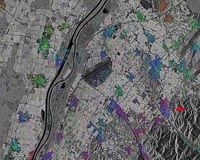 |
Tel Aviv, Israel (SPX) Oct 27, 2009 One small step for mankind is now a leap for averting natural and man-made disasters on earth. New Tel Aviv University technology combines sophisticated sensors in orbit with sensors on the ground and in the air to create a "Hyperspectral Remote Sensor" (HRS). It can give advance warnings about water contamination after a forest fire, alert authorities of a pollution spill long before a red flag is raised on earth, or tell people in China where a monsoon will strike. Prof. Eyal Ben-Dor of TAU's Department of Geography describes his team's HRS technology as a combination of physical, chemical and optical disciplines. "When a devastating forest fire hits the Hollywood Hills, for example, we can see from space how the mineralogy of the soil has changed," he explains. "Because of these changes, the next rainstorm may wash out all the buildings or leach contaminants into the soil. With our new tool, we can advise on how to contain the pollutants after the fire, and warn if there is a risk for landslides." Details on new applications of this technology were presented recently in several leading journals including Soil Science Society of America Journals, Soil Science Journal and the International Journal of Remote Sensing.
Putting a price on dirt "Water is an expensive commodity today," says Prof. Ben Dor. "Knowing how to better manage water resources is a top priority for states like California, and our new tool could help them do that." Today, it can take years before authorities can detect chemicals that can compromise our health. For example, about 90% of all gas stations leak contaminants into the soil, says Prof. Ben-Dor. His new HRS can monitor gas stations and identify problematic areas. "Our space sensors combined with ground measurements and GPS data will be able to detect and map hydrocarbon contamination in real time. Within a year, we'll be able to identify these problematic areas far more quickly than with traditional methods," he says.
Seeing where Earth takes the heat "These are not regular maps at all," says Prof. Ben-Dor. "We are combining properties from the physical, chemical and optical worlds, using all the latest technologies available from these fields. Ours is one of a few leading teams in the world exploring this novel way of mapping earth." These "soil maps" supply a bigger picture. Water bodies and sediment runoff in California. A small soil patch in a California forest after a fire. Impending monsoons and floods in China. Contaminants surrounding a factory. All these can literally be "seen" from space with the HRS. Previous research by Prof. Ben-Dor, which focused on mapping urban heat islands from space, is now regularly used by cities and urban planners to develop projects such as "green" roofs or new parks. Share This Article With Planet Earth
Related Links American Friends of Tel Aviv University Earth Observation News - Suppiliers, Technology and Application
 TerraSAR-X Image Of The Month: Ground Uplift Under Staufen's Old Town
TerraSAR-X Image Of The Month: Ground Uplift Under Staufen's Old TownBonn, Germany (SPX) Oct 22, 2009 The image, acquired by the German radar satellite TerraSAR-X, shows part of the southern Rhine Rift Valley near Freiburg and the city of Staufen (red arrow). To create this image, two separate images that were acquired by the satellite six months apart during 2008 were combined to form what is known as an interferogram. In the built-up area of Staufen, a clear pattern of deformation can ... read more |
|
| The content herein, unless otherwise known to be public domain, are Copyright 1995-2009 - SpaceDaily. AFP and UPI Wire Stories are copyright Agence France-Presse and United Press International. ESA Portal Reports are copyright European Space Agency. All NASA sourced material is public domain. Additional copyrights may apply in whole or part to other bona fide parties. Advertising does not imply endorsement,agreement or approval of any opinions, statements or information provided by SpaceDaily on any Web page published or hosted by SpaceDaily. Privacy Statement |